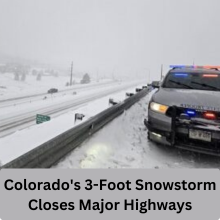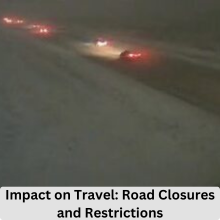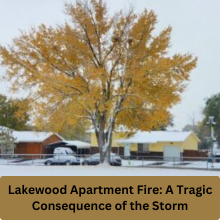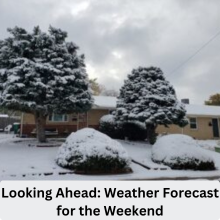Colorado’s first major winter storm of the season has brought the state to a standstill, with some areas receiving nearly three feet of snow and major travel disruptions. As a result, Governor Jared Polis declared a disaster emergency, activating the Colorado National Guard and state emergency operations centers to support residents impacted by the storm. Here’s an in-depth look at the storm’s effects, the response from authorities, and how Coloradans are dealing with the aftermath.
The Storm’s Timeline and Intensity
The storm began sweeping across Colorado on Friday, bringing heavy snow and strong winds. While winter storms are a common occurrence in the state, this storm, with its intensity and widespread impact, caught many off guard. Southern Colorado, the Eastern Plains, and mountain areas were hit hardest, with snow accumulating at alarming rates in just a few hours.
In many parts of Colorado, snow was falling at a rapid pace, with some areas seeing up to 3 inches per hour. By Friday evening, snow had reached record levels, leading to significant closures and travel delays.
Snowfall Reports and Key Locations
As the storm unfolded, meteorologists reported staggering snowfall totals. Some of the hardest-hit areas include:
- Cuchara: A staggering 35 inches of snow
- Rye and Genoa: Nearly 28 inches of snow
- Pinecliffe: 22 inches of snow
Denver, typically not as affected by the heaviest snowfalls, saw a moderate accumulation. By Friday morning, snow totals included:
- Denver: 9 inches
- Aurora: 13 inches
- Highlands Ranch and Lakewood: 15 inches
These totals highlight the storm’s extreme variability. While Denver and the surrounding metro area saw a few inches of snow, southern and mountain regions saw heavy snowfalls that led to dangerous driving conditions.
Gov. Jared Polis Declares a Disaster Emergency
In response to the storm’s impacts, Governor Jared Polis declared a disaster emergency. This declaration authorized the activation of the Colorado National Guard to assist in emergency response efforts. The move also activated the state’s emergency operations center, which coordinates disaster response across state agencies. The National Guard was tasked with helping those stranded in snowbanks, clearing roads, and providing assistance to affected residents.
The governor’s swift action was aimed at ensuring that state resources were immediately mobilized to address the crisis. In a statement, Gov. “This winter storm has caused major disruptions to travel, power and safety across the state,” Polis said. We are working closely with local officials to ensure that every necessary resource is available.”
Impact on Travel: Road Closures and Restrictions
One of the biggest challenges during the storm was the impact on Colorado’s transportation network. Major highways and interstates were shut down, and authorities put restrictions in place to prevent accidents and facilitate road clearing.
By Friday night, several major roadways were closed, including:
- I-70: Closed from Aurora to Kansas
- I-25: Closed from Pueblo to New Mexico
- U.S. 285: Closed through parts of southern Colorado
Additionally, commercial motor vehicles and trailers were banned on several major routes, including I-70, I-25, U.S.285, and U.S. 6. The Colorado Department of Transportation (CDOT) imposed these restrictions to prevent spinouts and traffic jams, which can further complicate road clearing efforts.
The snow was especially problematic in the mountain areas, where even experienced drivers were having difficulty navigating the steep, icy conditions.
Travel Safety Measures: CDOT’s Response
The Colorado Department of Transportation (CDOT) worked tirelessly to clear roads and keep the public safe. CDOT’s decision to ban large vehicles and trailers was critical in preventing major accidents, especially on highways prone to severe weather conditions. The goal was to reduce the risk of semi-truck spinouts, which can block lanes and require specialized equipment to remove.
CDOT also worked with local law enforcement to ensure that stranded drivers received assistance, with several emergency shelters set up across the state for those who needed them.
Denver International Airport Faces Major Disruptions
The storm didn’t just affect ground travel—it also caused major disruptions at Denver International Airport (DIA). More than 1,300 flights were canceled or delayed on Friday, stranding thousands of passengers. Airlines like SkyWest, Southwest, and Frontier were among the hardest-hit, with hundreds of cancellations affecting travelers.
Travelers were frustrated, but DIA worked to manage the chaos, directing passengers to alternative flights and rebooking options. Despite efforts to keep things moving, the sheer volume of cancellations made for a challenging day at the airport. For many, the weather meant that getting home or reaching their destination was delayed for hours, or even days.
Lakewood Apartment Fire: A Tragic Consequence of the Storm
The storm also had tragic consequences in Lakewood, Colorado, where a fire broke out in an apartment building early Friday morning. Authorities reported that a space heater, used to prevent pipes from freezing, sparked the fire around 5 a.m. Tragically, the fire destroyed the building and claimed the lives of two cats, while four residents were displaced.
The incident highlights the dangers of extreme cold temperatures and the importance of safe heating practices during winter storms. Fire officials urged Coloradans to be cautious when using space heaters and to ensure that all fire safety measures are followed.
Xcel Energy’s Response to Power Outages
While power outages were not as widespread as initially feared, Xcel Energy did report isolated outages across the state, mostly due to fallen trees and power lines weighed down by heavy snow. However, the storm did not lead to the major power disruptions that many had feared, and Xcel Energy worked quickly to restore power in affected areas.
By Friday night, the utility company had deployed repair crews to restore service, and by Saturday morning, most outages had been cleared.
Also read: James Van Der Beek Reveals Vasectomy Before Colon Cancer Battle
Warnings and Recommendations for Coloradans
As the storm continued, Colorado’s officials issued several warnings for residents to stay off the roads unless absolutely necessary. Weather advisories urged residents to take precautions against freezing temperatures and to stay informed about travel conditions.
Officials also reminded people to keep emergency supplies on hand, including extra blankets, water, and food, in case of power outages or extended travel disruptions.
Looking Ahead: Weather Forecast for the Weekend
By Saturday noon, snow was expected to taper off, but travel disruptions would likely continue throughout the weekend. State and local officials advised residents to remain cautious, especially if they needed to travel on highways or through mountainous areas.
Though the worst of the storm had passed, the risk of icy conditions remained, and Coloradans were advised to be prepared for continued impacts.
The Impact on Colorado’s Economy and Daily Life
The storm disrupted daily life across Colorado. Many businesses were forced to close, and schools canceled classes for the day. The economic impact of such a large-scale storm is always significant, with lost productivity and damage to property.
Government services also experienced delays, including local government offices and the processing of state services. As always, the most vulnerable populations, including the elderly and those without access to transportation, were particularly impacted by the storm.
How Coloradoans are Preparing for Future Storms
This storm is a reminder of the importance of being prepared for the challenges that winter weather brings. Coloradans have learned valuable lessons from this event, and local authorities are continuing to refine their emergency response strategies. Public education campaigns will focus on safe driving during winter months and emergency preparedness.
Also read: Why ChatGPT Is Down & When the ‘Bad Gateway’ Error Will Be Fixed
Conclusion
Colorado’s first major winter storm of the season has certainly left its mark, with significant snowfall, road closures, and widespread travel disruptions. However, the state’s quick response and the resilience of its residents have helped mitigate the worst of the impact. As winter continues, Coloradans can take comfort in the lessons learned and the strength of their communities.
FAQs
-
How much snow fell in Colorado’s first major storm of the season?
- Some areas received nearly three feet of snow, while Denver saw about 9 inches.
-
Why was a disaster emergency declared for this storm?
- The storm caused widespread disruptions, prompting the activation of emergency response teams and resources.
-
What caused the Lakewood apartment fire during the storm?
- A space heater, used to prevent pipes from freezing, sparked the fire early Friday morning.
-
How did the storm affect air travel at Denver International Airport?
- Over 1,300 flights were canceled or delayed due to the storm’s impact on visibility and flight schedules.
-
What precautions should Coloradans take during severe winter storms?
- Stay off the roads unless necessary, keep emergency supplies on hand, and ensure safe heating practices to prevent fires.



